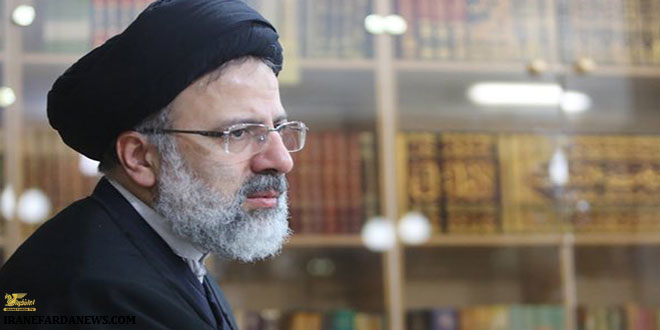
By: Saeed Kamali Dehghan Iran Monday 9 January 2017 12.53 EST
Many believe the custodian of the Islamic Republic’s holiest shrine is being groomed by Ayatollah Ali Khamenei’s inner circle
A 56-year-old conservative cleric relatively unknown to the outside world is quietly emerging as a frontrunner to be Iran’s next supreme leader.
Ebrahim Raisi is the custodian of Astan Quds Razavi, the wealthiest charity in the Muslim world and the organisation in charge of Iran’s holiest shrine. It is believed he is being groomed to be a leading candidate to succeed 77-year-old Ayatollah Ali Khamenei.
Khamenei’s tenure, which has spanned more than a quarter-century, will end only with his death; but the sudden death on Sunday of Ayatollah Hashemi Rafsanjani, the country’s greatest political survivor, has revived speculation about the succession. In 2014, Khamenei, the country’s ultimate decision-maker and its commander-in-chief, was announced to have undergone prostate surgery, which broke a taboo on the topic.
Rafsanjani, who will be buried on Tuesday, was a major political force in Iran. Although his influence had diminished in recent years as he shifted his political allegiance to reformists, he was still considered to have influence in pushing for a more moderate candidate to succeed Khamenei.
Rafsanjani revealed in a newspaper interview in June that two people had been shortlisted by the assembly of experts, the clerical body in charge of choosing the next supreme leader, although there has been no official confirmation.
Three others touted are ayatollahs Hashemi Shahroudi and Sadeq Larijani, the former and current judiciary chiefs, and the current president, Hassan Rouhani. Raisi is closer to Khamenei’s inner circle but has comparatively little executive experience.
Raisi’s rise in prominence since his appointment in March has surprised many political commentators. He wears a black turban, indicating he is a seyed – a descendant of the prophet Muhammad, in Shia Islam. Mohsen Kadivar, who has taught at Qom seminary, Iran’s most prominent Shia religious hub, said this fact alone increases his chances of gaining the top job by 30 to 40%. Ayatollah Shahroudi is also a seyed.
Hossein Rassam, a former Iran adviser to the British Foreign Office, said Raisi’s current role is a strong platform for his leadership chances. “He is the guardian for a shrine that is the destination of millions of Shia pilgrims every year and I think that is extremely important,” Rassam said. Nearly 30 million pilgrims are estimated to visit Imam Reza each year.
“He has also very close links to key players in the Islamic Republic [of Iran], from the supreme leader himself to the revolutionary guards. All the signs suggest … his chances of becoming the next supreme leader are growing very fast.”
Raisi had barely reached adulthood by the 1979 Islamic Revolution, but rose quickly through the ranks. In the summer of 1988, he was one of the four sharia
judges behind the mass execution of leftists and dissidents.
More recently he was Iran’s prosecutor-general and still holds a very important division within the judiciary as the head of the court that prosecutes troublemaking clerics. He is married to the daughter of a hardline ayatollah who is the representative of Khamenei in the eastern province of Khorasan-Razavi, home to the Imam Reza shrine.
Rassam said Raisi is also advantaged by Shahroudi and Larijani’s involvement in corruption cases, and the distance he has kept from Iran’s factional infighting. His role in the mass execution of political dissidents in the 1980s is unlikely to damage his standing, Rassam said, while pictures that emerged of senior military commanders symbolically sitting at his feet during a visit to Raisi in Mashhad underlined his authority.
Morteza Kazemian, a prominent political activist living in exile in Paris, said Raisi’s relations with the Revolutionary Guards, intelligence agencies and Khamenei’s inner circle – including his son Mojtaba – made him the frontrunner to be the next supreme leader.
“Raisi’s chances are high, but what will happen the day Khamenei dies rests much on the political balance at that exact moment,” he said.
Kadivar, who is currently a research professor at Duke University, stuck a more cautious note. Although he sees Raisi as a potential candidate, he believes there are not sufficient signs to consider him the frontrunner.
“Khamenei’s authority is effective so long as he is alive but once he dies, all political allegiances may shift, which makes all the talk about potential candidates very speculative,” he warned.
“Rouhani’s chances are much bigger than the others. He has the experience, the Islamic knowledge and credibility among the elites.”
Kadivar, a strong critic of Islamic jurisprudence, believes there are signs that Khamenei wants to make constitutional changes to abolish the position of president, or make it symbolic and reinstate the role of prime minister. “Presidents in Iran have proved too troublesome for the supreme leader, while the parliament has usually acted within the red lines. A prime minister appointed by such a parliament would alleviate the leader’s concerns,” Kadivar said.
Another theory is that Khamenei could limit the term of the top job to 10 years, making the next supreme leader less supreme. And while many believe Khamenei’s character means he will want to choose his own successor, Rassam thinks the ayatollah will leave the decision to his confidantes and the assembly of experts will simply rubber-stamp the appointment.
And in Iran’s current climate, Raisi has “a very high chance of becoming the next supreme leader”, Rassam says.
 khalijefars News, Blogs, Art and Community
khalijefars News, Blogs, Art and Community








